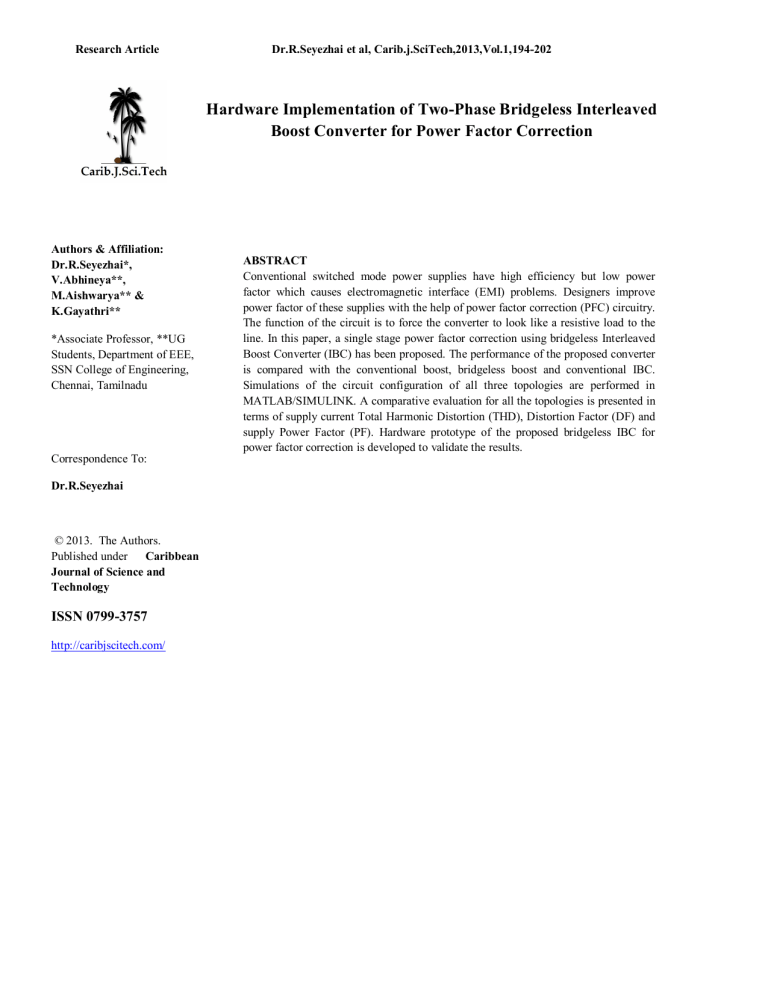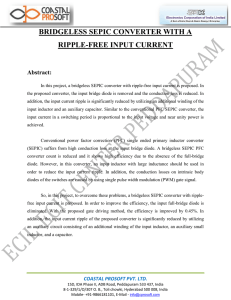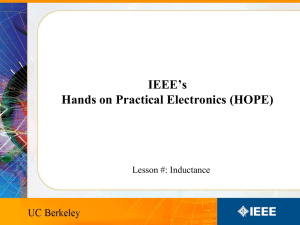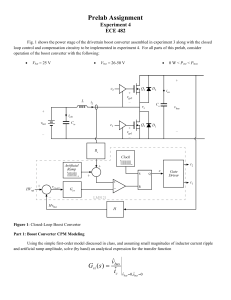Hardware Implementation of Two-Phase Bridgeless Interleaved

Research Article Dr.R.Seyezhai et al, Carib.j.SciTech,2013,Vol.1,194-202
Hardware Implementation of Two-Phase Bridgeless Interleaved
Boost Converter for Power Factor Correction
Authors & Affiliation:
Dr.R.Seyezhai*,
V.Abhineya**,
M.Aishwarya** &
K.Gayathri**
*Associate Professor, **UG
Students, Department of EEE,
SSN College of Engineering,
Chennai, Tamilnadu
ISSN 0799-3757
ABSTRACT
Conventional switched mode power supplies have high efficiency but low power factor which causes electromagnetic interface (EMI) problems. Designers improve power factor of these supplies with the help of power factor correction (PFC) circuitry.
The function of the circuit is to force the converter to look like a resistive load to the line. In this paper, a single stage power factor correction using bridgeless Interleaved
Boost Converter (IBC) has been proposed. The performance of the proposed converter is compared with the conventional boost, bridgeless boost and conventional IBC.
Simulations of the circuit configuration of all three topologies are performed in
MATLAB/SIMULINK. A comparative evaluation for all the topologies is presented in terms of supply current Total Harmonic Distortion (THD), Distortion Factor (DF) and supply Power Factor (PF). Hardware prototype of the proposed bridgeless IBC for power factor correction is developed to validate the results.
Correspondence To:
Dr.R.Seyezhai
© 2013. The Authors.
Published under Caribbean
Journal of Science and
Technology http://caribjscitech.com/
Research Article Dr.R.Seyezhai et al, Carib.j.SciTech,2013,Vol.1,194-202
1. INTRODUCTION
DC power supplies are extensively used in many of the electrical and electronic appliances such as in computers, audio sets, televisions, and others. The presence of non linear loads results in low power factor operation of the power system. The basic block in many power electronic converters are uncontrolled diode bridge rectifiers with capacitive filter. Due to the non-linear nature of bridge rectifiers, non-sinusoidal current is drawn from the utility and harmonics are injected into the utility lines. The bridge rectifiers contribute to high THD, low PF, and low efficiency to the power system. These harmonic currents cause several problems such as voltage distortion, heating, noises etc. which results in reduced efficiency of the power system. Due to this fact, there is a need for power supplies that draw current with low harmonic content and also have power factor close to unity. This results in the corporation of power factor correction circuits. These circuits help to reduce the line current harmonics.
Traditionally there are two ways of shaping the input current waveform so that the overall off-the-line AC-DC converter is seen as a resistive load by the ac mains. Firstly, by employing filters the power factor is improved: Passive Power Factor Correction
(PPFC) ands secondly by using proper DC-DC converters, the supply current is shaped: Active Power Factor Correction
(APFC).PPFC increases the size of the system and therefore, currently, many researchers are working towards different topologies for APFC [1]. Active power factor correction involves reactive elements in conjunction with active switches, such as IGBTs,
MOSFETs and thyristor which are switched at a desirable predetermined frequency [2-4]. These topologies result in source current shaping due to the fact that the active PFC topology always draws current in phase and at the same frequency as the line voltage. Thus, the power factor improves as the load becomes linear in nature Following are some of the advantages of active PFC topologies:
Controllable output voltage can be obtained
Reduced harmonic distortion in line current
Cheaper and less bulky components required
Only part of the power is handled by the switching devices, resulting in higher efficiency
Based on the frequency of switching of the active devices involved, active power factor correction can be classified as: Low
Frequency active power factor correction and High Frequency active power factor correction. In general, high frequency active power factor correction is preferred due to slow regulation of output voltage and the large size of reactive elements in low frequency active power factor correction topologies. In high frequency active power factor correction circuits, the load behaves like a resistor which brings the power factor closer to unity, thus minimizing the harmonics. Therefore, this paper focuses on the design and implementation of a two-phase bridgeless IBC for improving the power quality of the supply current waveform. The performance of the proposed converter is compared with various active PFC topologies namely the Buck Converter, Boost
Converter and the Interleaved Boost Converter topologies [5-6]. Simulation studies are carried out in MATLAB/SIMULINK. A hardware model of the bridgeless IBC is implemented by employing MOSFET and the results are validated.
2. BRIDGELESS INTERLEAVED BOOST CONVERTER
This topology employs a bridgeless boost converter for active power factor correction. The prime feature of this topology is that the need for input diode bridge rectifier stage is eliminated completely, while still maintaining the classic boost topology [7-9].
The circuit diagram is shown in Fig.1. The Bridgeless Interleaved Boost Converter (IBC) topology for active power factor correction consists of a number of boost converters operating in parallel. The input diode bridge rectifier stage is eliminated while still maintaining the classic IBC structure. This topology affords a number of advantages in comparison to the conventional topologies. It addresses the heat management problem caused by the input diode rectifier stage of IBC. In effect, the bridgeless
IBC topology combines the benefits of both the bridgeless topology and the interleaved structure. In the Bridgeless Interleaved
Boost Converter topology, the rectifier stage is integrated with the high frequency converter. Due to the elimination of the bridge rectifier stage, the circuit becomes less bulky. Interleaving leads to an increase in the frequency of input current ripples and hence a reduction in the weight and volume of EMI filters required. The conduction losses are greatly reduced due to the presence of fewer number of semiconductor devices in each conduction path. In comparison to a two-phase IBC, a two-phase bridgeless IBC topology uses two extra MOSFETs and fast diodes, instead of the four slow diodes in the bridge rectifier stage. This converter topology thus affords the maximum efficiency due to the combined merits of interleaving and the bridgeless structure.
195
Research Article Dr.R.Seyezhai et al, Carib.j.SciTech,2013,Vol.1,194-202
Fig.1 Bridgeless Interleaved Boost DC-DC Converter
For analysis of the topology, the circuit is separated into two half cycles. Q1 and Q2 are turned on at the same instant and Q3 and
Q4 are turned on at the same instant which is 180 ˚ out of phase with respect to the instants of Q1 and Q2. During the positive half cycle, Q1 and Q2 are turned ON and the current flows through L1, Q1, Q2 and L2 thereby storing energy in L1 and L2. When Q1 and Q2 are turned off, the energy stored in L1 and L2 are released as current through D1, load, body diode of Q2 and is fed back to the mains. Similarly, with a shift of 180 ˚, Q3 and Q4 are turned ON and energy is stored in L3 and L4 via Q3 and Q4. Durin g the negative half cycle, Q4 and Q2 are turned ON, energy gets stored in L2 and L1 for the first phase and L4 and L3 for the next phase and gets released as current which flows through D2 (D4), load, body diode of Q1 (Q3) and back to mains [10-12].
A new loss has been introduced in the intrinsic body diodes of the FETs, but since input bridge rectifiers are eliminated, there is some efficiency gain in overall performance of the topology. Overall, the MOSFETs are under more stress in bridgeless IBC topology, but the total loss for the proposed bridgeless interleaved boost are 40% lower than the benchmark conventional boost,
27% lower than the bridgeless boost and 32% lower than the interleaved boost . Since the bridge rectifier losses are so large, it is expected that bridgeless interleaved boost converter would have the least power losses in comparison to the other five topologies, discussed above [13-15]. It is to be noted that the losses in the input bridge rectifiers constitute 63% of total losses in conventional
PFC converter and 71% of total losses in interleaved PFC converter. Therefore eliminating the input bridges in PFC converters is justified despite the fact that new losses are introduced.
3. SIMULATION RESULTS
The simulation circuit for the bridgeless interleaved boost converter is shown in Fig.2 and the design parameters are shown in
Table: 1 for the proposed topology.
Fig.2 Simulation circuit for the Bridgeless Interleaved Boost Converter
Research Article Dr.R.Seyezhai et al, Carib.j.SciTech,2013,Vol.1,194-202
Table 1 : Design parameters for the implementation of Bridgeless Interleaved Boost Converter Topology
Parameters Values
25kHz Switching Frequency
Input Voltage
Output Voltage
Duty Ratio
R1, R2, R3, R4
L1, L2, L3, L4
C
R
20V
40V
0.5
25milli ohms
667uH
975uF
47.06
Ω
The simulation results for the supply voltage and supply current for bridgeless IBC is shown in Fig.3.The proposed topology is compared with Buck, Boost, Bridgeless boost and Interleaved boost rectifier is shown in Table :2.
Fig. 3 Supply voltage and Supply Current Waveforms for
Bridgeless Interleaved Boost Converter
197
Research Article Dr.R.Seyezhai et al, Carib.j.SciTech,2013,Vol.1,194-202
Table :2 Comparative results of the performance parameters of the various Active Power Factor Correction Topologies
Topology THD (%)
Rectifier +Buck
Rectifier +Boost
147.93
95.94
Distortion Factor
(kp)
0.5600
0.7220
Displacement Factor
(kd)
Power factor (pf)
0.7180
0.8780
0.4020
0.6330
Interleaved Boost
Bridgeless Boost
75.11
69.12
0.7990
0.8226
0.9290
0.9995
0.7420
0.8222
Bridgeless IBC 68.43 0.8252 0.9995 0.8248
From Table-2, it is found that the bridgeless IBC topology has the lowest value of Total Harmonic Distortion (THD) and the highest power factor of 0.9995. Hence this topology is chosen for implementation purpose.
4. HARDWARE IMPLEMENTATION
The following components are required to implement the Bridgeless Interleaved Boost Converter Topology for Active Power
Factor Correction.
Topology
Table : 3 Hardware Components for Bridgeless IBC
Specifications
Transformer
Bridge rectifier
Voltage regulator
Power MOSFET
Power Diode
Smoothing capacitor
Optocoupler
230V/15V , 1A
230V/24V, 1A
15V
IRFP460A
1N5408
220uF
MCT2E
4.1 Implementation of the Gating Circuit
The gating circuit basically involves the PIC18F4550 microcontroller which is programmed to generate the necessary switching pattern to trigger the MOSFETs of the power circuit.[16-19] As shown in Fig.4. The gating circuit is isolated from the power circuit using the MCT2E optocouplers. The 15 V DC supply to the optocoupler is obtained by feeding the 230 V AC supply to a network which comprises a transformer, diode bridge rectifier, filtering capacitor and a voltage regulator. The output of the
198
Research Article Dr.R.Seyezhai et al, Carib.j.SciTech,2013,Vol.1,194-202 optocoupler is given across the gate and source terminals of the MOSFETs. The converter’s output can be seen across the Cathode
Ray Oscilloscope (CRO). The schematic diagram is as shown below:
Fig.4 Block Diagram showing the implementation of the optocoupler circuit
The PIC microcontroller generates the necessary switching pulses to be provided as input to the optocoupler IC 4N33 as shown in
Figs.5,6 &7. The output of the optocoupler then triggers the Power MOSFETs. Two of the switches in the Bridgeless IBC topology are triggered at a frequency of 25 KHz (0.04 ms) while the other two switches are triggered at the same frequency, but with a phase lag of 180 degrees (i.e. a time lag of 0.02 ms). This switching pattern is generated at two output pins of the PIC microcontroller (pins 19 & 20- RD0 and RD1 respectively).
Fig.5. Two 180 degree phase shifted square waves from the PIC
inputs to the optocoupler
199
Research Article Dr.R.Seyezhai et al, Carib.j.SciTech,2013,Vol.1,194-202
Fig.6. Implementation of the optocoupler circuit
Fig.7 Switching Pulse generated across the optocouple output terminals
The overall hardware for the bridgeless IBC is shown in Fig.8.
Fig.8. Implementation of the power circuit
200
Research Article Dr.R.Seyezhai et al, Carib.j.SciTech,2013,Vol.1,194-202
Fig.9 shows for an input of 9V, the output voltage obtained is shown in PQ meter as 18.68V as the chosen duty ratio is 0.5.
Fig.9 Multimeter showing the Input Voltage and Power Quality Analyzer showing the output voltage for the proposed
IBC
Fig.10 shows that the supply power factor obtained is about 0.713 which is close to simulation results.
Fig.10. Experimental value of the power factor measured
using the Power Quality Analyzer
6. CONCLUSION
This paper deals with a novel AC-DC converter topology, namely the Bridgeless IBC topology for active power factor correction.
A comparative analysis of the performance parameters of the buck, boost, interleaved boost, bridgeless boost and bridgeless
201
Research Article Dr.R.Seyezhai et al, Carib.j.SciTech,2013,Vol.1,194-202 interleaved boost converter topologies for active power factor correction, has been carried out. The performance parameters obtained show that the bridgeless IBC topology affords the least total harmonic distortion and hence, the best power factor, which justifies its choice for final implementation purposes. The two phase Bridgeless IBC topology has thus been implemented in the open loop configuration. The experimental results obtained are found to closely match the simulation results.
REFERENCES
1.
Balogh.L and Redl.R (1993), Power-factor correction with interleaved boost converters in continuous-inductor- current mode – Applied Power Electronics Conference and Exposition (APEC), Eighth Annual Conference Proceedings, Print
ISBN: 0-7803-0983-9, pp. 168 – 174.
2.
Chen Zhou and Milan M. Jovanovic (2011), Design Trade – offs in Continuous Current-Mode Controlled Boost Power-
Factor Correction Circuits - Seventh International High Frequency Power Conversion (HFPC) Conf., San Diego, CA, pp.
209-220.
3.
Hasaneen B.M. and Mohammed (2008), A.A.E., Design and simulation of DC/DC boost converter, 12th International
Middle-East Power System Conference, pp.335 - 340 .
4.
Jian Li (2009), Current-Mode Control: Modelling and its Digital Application- Dissertation, Virginia Polytechnic Institute and State University, Blacksburg, Virginia.
5.
Joel Turchi (2003), Power Factor Correction Stages Operating in Critical Conduction Mode- Semiconductor
Components Industries, LLC − Rev. 1 Publication Order Number: AND8123/D .
6.
Kornetzky, Peter,etel (1997), A single-Switch AC/DC Converter with Power Factor Correction -
ElectronicsLetters.Vol.33, no.25, pp.2084-2085
7.
Kurma Sai Mallika (2007), Topological Issues In Single Phase Power Factor Correction – Department of Electrical
Engineering National Institute of Technology, Rourkela-769008
8.
Lai, J. S., (1993),Design consideration for Power Factor Correction Boost converter operating at the Boundary of
Continuous Conduction mode and Discontinuous Conduction mode - Proc. of IEEE Applied Power Electronics
Conference(APEC) ,pp. 267-273
9.
Lee . P, Lee . Y, D.K.W. Cheng and X.Liu (2000),Steady-state analysis of an interleaved boost converter with coupled inductors - IEEE Trans. Industrial Electronics, pp. 787–79
10.
Marsh.D (2000), Active Power FactorCorrection–EDNMagazine,,pp.31 – 41
11.
Redl, Richard, et el (1994), Power factor correction in single-phase switching mode power supplies – an overview
Int.J.Electronics.vol.77, no.5, pp. 555-582
12.
Rossetto. L., Spiazzi G., Tenti P. (1994), Control techniques for power factor correction converters - Power Electronics and Motion Control (PEMC), September, pp. 1310-1318
13.
Santosh A and Shivashankar Tallada (2012), Simulation Of High-Efficiency AC/DC Converter For Power Factor
Correction - International Journal of Engineering Research and Applications(IJERA)ISSN:2248-9622, Vol. 2, Issue4, pp.2043-2050
14.
Seyezhai. R and B.L. Mathur (2011), Design and implementation of fuel cell based Interleaved Boost Converter–
International Conference on Renewable Energy. ICRE 2011 University of Rajasthan, Jaipur
15.
Woo-Young Choi, Jung-Min Kwon, Eung-Ho Kim, Jong-Jae Lee, and Bong-Hwan Kwon, Member, IEEE
(2007),Bridgeless Boost Rectifier With Low Conduction Losses and Reduced Diode Reverse-Recovery Problems - IEEE transactions on industrial electronics, vol. 54, no. 2, pp. 769 - 780
16.
Datasheet of Voltage Regulator LM7815
17.
Datasheet of Optocoupler IC MCT2E
18.
Datasheet of Power MOSFET IRFP460A
19.
Datasheet of PIC Microcontroller - PIC 18F4550
202


